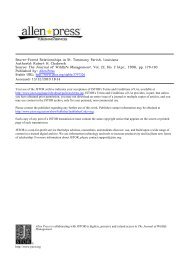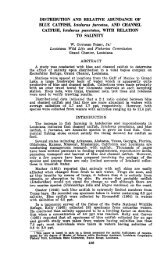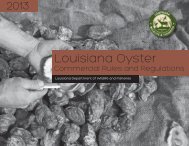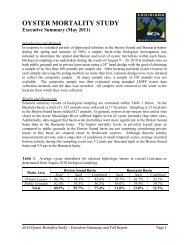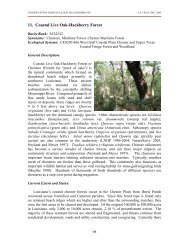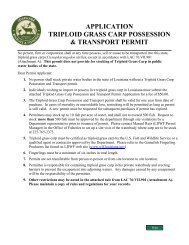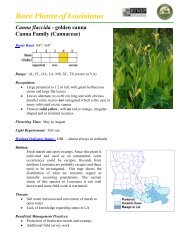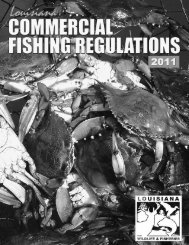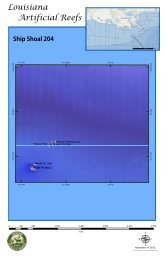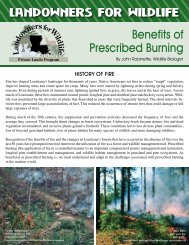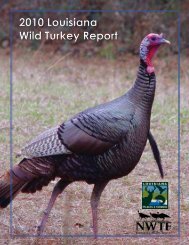Bottomland Hardwood Forest - Louisiana Department of Wildlife and ...
Bottomland Hardwood Forest - Louisiana Department of Wildlife and ...
Bottomland Hardwood Forest - Louisiana Department of Wildlife and ...
You also want an ePaper? Increase the reach of your titles
YUMPU automatically turns print PDFs into web optimized ePapers that Google loves.
CONSERVATION HABITATS & SPECIES ASSESSMENTS LA CWCS--DEC 20056. <strong>Bottoml<strong>and</strong></strong> <strong>Hardwood</strong> <strong>Forest</strong>Rarity Rank: S4/G4G5Synonyms: Mixed <strong>Bottoml<strong>and</strong></strong> <strong>Hardwood</strong>s, Broad Stream Margins, <strong>Hardwood</strong> BottomsEcological Systems:CES203.512 Lower Mississippi River <strong>Bottoml<strong>and</strong></strong> <strong>and</strong> Floodplain <strong>Forest</strong>CES203.489 East Gulf Coastal Plain Large River Floodplain <strong>Forest</strong>CES203.065 Red River Large Floodplain <strong>Forest</strong>CES203.488 West Gulf Coastal Plain Large River Floodplain <strong>Forest</strong>General Description:<strong>Bottoml<strong>and</strong></strong> hardwood forests areforested, alluvial wetl<strong>and</strong>s occupyingbroad floodplain areas that flank largeriver systems. These forests are foundthroughout <strong>Louisiana</strong> in all parishes, butare the predominant natural communitytype <strong>of</strong> the Mississippi River AlluvialPlain. They also play a major role in theEGCP where they are predominantlyassociated with the Pearl, <strong>and</strong> BogueChitto River floodplains, with someadditional areas along the Tangipahoa, Natalbany, Tickfaw <strong>and</strong> Amite Rivers (Smith1999b). <strong>Bottoml<strong>and</strong></strong> hardwood forests are characterized <strong>and</strong> maintained by a naturalhydrologic regime <strong>of</strong> alternating wet <strong>and</strong> dry periods generally following seasonalflooding events. These forests support distinct assemblages <strong>of</strong> plants <strong>and</strong> animalsassociated with particular l<strong>and</strong>forms, hydric soils, <strong>and</strong> hydrologic regimes. They areimportant natural communities for maintenance <strong>of</strong> water quality, providing a veryproductive habitat for a variety <strong>of</strong> fish <strong>and</strong> wildlife species, <strong>and</strong> are important inregulating flooding <strong>and</strong> stream recharge. <strong>Bottoml<strong>and</strong></strong> hardwoods are extremelyproductive areas due in part to periodic flood-transported <strong>and</strong> deposited particulate <strong>and</strong>dissolved organic matter <strong>and</strong> nutrients (LNHP 1986-2004). In general, forestedfloodplain habitats are mixtures <strong>of</strong> broadleaf deciduous, needleleaf deciduous, <strong>and</strong>evergreen trees <strong>and</strong> shrubs. <strong>Bottoml<strong>and</strong></strong> hardwood forests contain a number <strong>of</strong> specieswhich can be aggregated into specific associations or communities based onenvironmental factors such as physiography, topography, soils, <strong>and</strong> moisture regime(Allen 1997, The Nature Conservancy 2004). In the far eastern portion <strong>of</strong> the EGCP,along the lower Pearl River, several species associations are recognized with Quercuslaurifolia (laurel oak) being the community dominant <strong>and</strong> Persea borbonia (red bay)being common in the understory (White 1983).73
CONSERVATION HABITATS & SPECIES ASSESSMENTS LA CWCS--DEC 2005The following are three associations recognized by the LNHP in bottoml<strong>and</strong>hardwood forests <strong>of</strong> <strong>Louisiana</strong> (LNHP1986-2004):1). Overcup Oak - Water Hickory <strong>Bottoml<strong>and</strong></strong> <strong>Forest</strong>Quercus lyrata (overcup oak) <strong>and</strong> Carya aquatica (water hickory) are codominants<strong>of</strong> this floodplain forest which occurs on low-lying poorly drained flats, sloughs in thelowest backwater basins, <strong>and</strong> on low ridges with clay soils that are subject to inundation.Semi-permanently inundated or saturated soils are generally present for major portion <strong>of</strong>the growing season. Associate species include Fraxinus pennsylvanica (green ash),Celtis laevigata (hackberry), Cornus foemina (swamp dogwood), <strong>Forest</strong>iera acuminata(swamp privet), Planera aquatica (planertree), Cephalanthus occidentalis (buttonbush)<strong>and</strong> vines. This community type has a long successional stage.2). Hackberry-American Elm-Green Ash <strong>Bottoml<strong>and</strong></strong> <strong>Forest</strong>Celtis laevigata (hackberry), Ulmus americana (American elm), <strong>and</strong> Fraxinuspennsylvanica (green ash) are codominants. This community occurs in floodplains <strong>of</strong>major rivers on low ridges, flats <strong>and</strong> sloughs in first bottoms. Soils are seasonallyinundated or saturated periodically for 1 to 2 months during the growing season.Common associates are Carya aquatica (water hickory), Quercus texana (nuttall oak), Q.phellos (willow oak), Q. nigra (water oak), Q. lyrata (overcup oak), Liquidambarstyraciflua (sweetgum), Acer negundo (box elder), Ulmus alata (winged elm), Acerrubrum (red maple), Gleditsia aquatica (water locust) <strong>and</strong> Plantanus occidentalis(American sycamore). Understory species include Cornus foemina (swamp dogwood),Crataegus spp. (hawthorn), <strong>and</strong> Morus rubra (red mulberry). Many vines <strong>and</strong>herbaceous plants are present.3). Sweetgum-Water Oak <strong>Bottoml<strong>and</strong></strong> <strong>Forest</strong>The community dominants are Liquidambar styraciflua (sweetgum) <strong>and</strong> Quercusnigra (water oak). Major associates are Celtis laevigata (hackberry), Fraxinuspennsylvanica (green ash), Ulmus americana (American elm), <strong>and</strong> Q. texana (Nuttalloak). It occurs in alluvial floodplains, extensively in the Mississippi alluvial valley onwell drained first bottom ridges. Associated species are Acer rubrum (red maple), Morusrubra (red mulberry), Smilax spp. (greenbrier), Sabal minor (dwarf palmetto), Ilexdecidua (deciduous holly), Crataegus viridis (green hawthorn), Ampelopsis arborea(peppervine), Campsis radicans (trumpet creeper), <strong>and</strong> Toxicodendron radicans (poisonivy). Soils are seasonally saturated or inundated for up to 2 months during the growingseason.Current Extent <strong>and</strong> Status:<strong>Bottoml<strong>and</strong></strong> hardwood forest loss is estimated to be 50 to 75 % <strong>of</strong> the originalpresettlement acreage, statewide (Smith 1993). Old-growth examples <strong>of</strong> this habitat typeare very rare. In the MRAP, clearing for agricultural production was the primary factorthat led to fragmentation <strong>and</strong> decline <strong>of</strong> this habitat type. Large tracts <strong>of</strong> bottoml<strong>and</strong>74
CONSERVATION HABITATS & SPECIES ASSESSMENTS LA CWCS--DEC 2005hardwood forest remain but most are eithersecond or third growth st<strong>and</strong>s. This habitat canbe found within many <strong>of</strong> the WMAs managed byLDWF <strong>and</strong> on NWRs managed by the USFWS.WMAs support 304,982 acres <strong>of</strong> bottoml<strong>and</strong>hardwoods, while NWRs contain another 150,000acres. The U.S. Army Corps <strong>of</strong> Engineers (COE)oversees the Atchafalaya Basin Floodway whichis the largest remaining block <strong>of</strong> bottoml<strong>and</strong>hardwood forests <strong>and</strong> swamp in the U.S. (595,000acres) yet most <strong>of</strong> the basin remains in private ownership. <strong>Louisiana</strong>’s ECGP stillcontains extensive areas <strong>of</strong> bottoml<strong>and</strong> hardwood forest primarily along the Pearl <strong>and</strong>Bogue Chitto Rivers in St. Tammany <strong>and</strong> Washington Parishes, respectively. Much <strong>of</strong>this acreage is contained within the Bogue Chitto NWR, managed by the USFWS, <strong>and</strong>Pearl River WMA, operated by LDWF. The lower Tangipahoa <strong>and</strong> Natalbany Rivers inTangipahoa Parish, as well as the Tickfaw <strong>and</strong> Amite Rivers in Livingston Parish,support tracts <strong>of</strong> bottoml<strong>and</strong> forest (Smith 1999a, Smith 1999b). <strong>Louisiana</strong> State Parksincluding Chicot, Lake Fausse Point, Tickfaw, Fontainebleau, <strong>and</strong> Bogue Chitto supportbottoml<strong>and</strong> hardwood forests. Other small privately owned bottoml<strong>and</strong> hardwood sitesare located within all parishes in the state, <strong>and</strong> a total <strong>of</strong> 4,400 acres <strong>of</strong> combinedbottoml<strong>and</strong> hardwood forests <strong>and</strong> swamps are registered with the <strong>Louisiana</strong> NaturalAreas Registry Program. Restoration efforts have been in progress since the 1980’s, <strong>and</strong>with the aid <strong>of</strong> the Conservation Reserve Program (CRP) <strong>and</strong> Wetl<strong>and</strong> Reserve Program(WRP) over 365,000 acres have been reforested in <strong>Louisiana</strong> (R. Marcantel, personalcommunication). Reconnecting fragmented forest blocks <strong>and</strong> restoration <strong>of</strong> wetl<strong>and</strong>forest functions are the major challenges to reforestation efforts <strong>and</strong> are essential toproviding adequate wildlife habitat in bottoml<strong>and</strong> hardwood forest systems.BOTTOMLAND HARDWOOD FORESTSPECIES OF CONSERVATION CONCERN (34)AMPHIBIANSSouthern Dusky Salam<strong>and</strong>er<strong>Louisiana</strong> Slimy Salam<strong>and</strong>erStrecker's Chorus FrogEastern SpadefootSouthern Crawfish FrogBIRDSYellow-crowned Night-HeronWood StorkSwallow-tailed KiteBald EagleAmerican WoodcockYellow-billed CuckooWood ThrushYellow-throated VireoNorthern ParulaProthonotary WarblerSwainson's Warbler<strong>Louisiana</strong> WaterthrushKentucky WarblerHooded WarblerField SparrowRusty BlackbirdOrchard OrioleBUTTERFLIESCelia's Roadside SkipperFalcate Orangetip'Seminole' Texan CrescentMAMMALSSoutheastern ShrewSoutheastern Myotis<strong>Louisiana</strong> Black BearLong-tailed WeaselEastern Spotted SkunkREPTILESAlligator Snapping TurtleWestern Worm SnakeCommon Rainbow SnakeTimber Rattlesnake75
CONSERVATION HABITATS & SPECIES ASSESSMENTS LA CWCS--DEC 2005Priority Species Research <strong>and</strong> Survey Needs:Strecker's Chorus Frog: The current status <strong>of</strong> this species in <strong>Louisiana</strong> is uncertain, <strong>and</strong> itmaybe extirpated. Intensive surveys are needed to update occurrence records <strong>and</strong>abundance for inclusion in LNHP database.Swallow-tailed Kite: Continue to inventory <strong>and</strong> monitor Swallow-tailed Kites on public<strong>and</strong> private l<strong>and</strong>s to fill data gaps in distribution <strong>and</strong> abundance for inclusion in theLNHP database <strong>and</strong> Audubon nationwide database. Begin research to determine theeffects <strong>of</strong> silviculture/l<strong>and</strong> management practices on this species.Rusty Blackbird: Initiate surveys to determine wintering population abundances <strong>and</strong>habitat use to augment Christmas Bird Counts.Songbirds: Continue to support research on silviculture/l<strong>and</strong> management practices <strong>and</strong>their effects on all songbird species in this habitat.Waterbirds: Continue to conduct rookery surveys to update the LNHP databaseinformation.'Seminole' Texan Crescent: Conduct surveys to determine current distribution <strong>and</strong>abundance for inclusion in the LNHP database.<strong>Louisiana</strong> Black Bear: Continue research on ecology <strong>and</strong> support repatriation efforts.Eastern Spotted Skunk: Considered critically imperiled in <strong>Louisiana</strong>, intensive surveysare needed to update occurrence records <strong>and</strong> abundance for inclusion in LNHP database.Southeastern Shrew: Considered imperiled in <strong>Louisiana</strong>. Together with Arkansas <strong>and</strong>Missouri, <strong>Louisiana</strong> represents the western edge <strong>of</strong> its range. Intensive surveys needed toupdate occurrence records <strong>and</strong> abundance for inclusion in LNHP database.Species Conservation Strategies:1. Swallow-tailed Kite: Implement conservation <strong>and</strong> management recommendations <strong>of</strong>SWG project T9 (Coulson 2004).2. Bald Eagle: Continue long-term monitoring <strong>of</strong> active bald eagle nests, successfulbreeding pairs, <strong>and</strong> fledged eagles.3. <strong>Louisiana</strong> Black Bear: Partner with the Black Bear Conservation Committee (BBCC),USFWS <strong>and</strong> continue to support the implementation <strong>of</strong> recovery efforts for thisspecies.4. American Woodcock: Develop partnerships with state <strong>and</strong> federal agencies, NGOs,<strong>and</strong> the private sector to implement the American Woodcock Management Plan.76
CONSERVATION HABITATS & SPECIES ASSESSMENTS LA CWCS--DEC 20055. Promote the use <strong>of</strong> appropriate silvicultural techniques to restore/manage <strong>Bottoml<strong>and</strong></strong><strong>Hardwood</strong> (BLH) forests for wildlife (include importance <strong>of</strong> tree species diversity, dentrees for birds <strong>and</strong> mammals, leaf litter, etc). Snags should be retained during loggingoperations for cavity-nesting wildlife species. Efforts need to be made to maintainsufficient levels <strong>of</strong> woody debris in st<strong>and</strong>s for reptiles, amphibians <strong>and</strong> smallmammals.6. Work with l<strong>and</strong>owners to initiate or continue the implementation <strong>of</strong> PIF birdconservation plans, conservation plans developed for amphibians <strong>and</strong> reptiles, <strong>and</strong>USFWS threatened <strong>and</strong> endangered species recovery plans over the next 10 years.7. Determine the microhabitat preferences <strong>and</strong> requirements <strong>of</strong> species utilizingbottoml<strong>and</strong> hardwood forest to underst<strong>and</strong> how these species are utilizing the habitatto determine management needs.Threats Affecting Habitat:The following table illustrates the threats identified for this habitat type <strong>and</strong> the sources<strong>of</strong> these threats. This represents all threats <strong>and</strong> sources <strong>of</strong> threats identified across allecoregions <strong>of</strong> the state where this habitat occurs.AlteredComposition/StructureHabitatDestruction orConversionHabitatDisturbanceThreatSource <strong>of</strong> ThreatChannelization<strong>of</strong> rivers or streamsXXX XXX XXXCommercial/industrialXXXXXXdevelopmentConstruction <strong>of</strong> ditches,drainage or diversion XXXXXXsystemsConversion to agricultureor other forest typesXXX XXX XXXCrop production practices XXX XXX XXX XXXHabitatFragmentationHerbivoryModification <strong>of</strong>Water Levels;Changes inNatural FlowPatternsDam construction XXX XXX XXXDevelopment/maintenance<strong>of</strong> pipelines, roads orutilitiesIncompatible forestrypracticesXXX XXX XXX XXXXXX XXX XXX XXXInvasive/alien species XXX XXX XXXOil or gas drilling XXX XXX XXXOperation <strong>of</strong> dams orreservoirsXXXXXXOperation <strong>of</strong> drainage ordiversion systemsXXX XXX XXX XXXPredation/Parasitism/DiseaseParasites/pathogens XXX XXXSedimentationToxins/ContaminantsRecreational use/vehiclesXXXResidential development XXX XXX XXX XXX77
CONSERVATION HABITATS & SPECIES ASSESSMENTS LA CWCS--DEC 2005Habitat Conservation Strategies:1. Continue to monitor nuisance species (nutria, beaver, etc.) <strong>and</strong> control them asneeded.2. Promote use <strong>of</strong> appropriate silvicultural techniques to restore/manage BLH forests forwildlife (include importance <strong>of</strong> tree species diversity), den trees for birds <strong>and</strong>mammals, etc.3. Encourage the use <strong>of</strong> BMP’s in the conservation <strong>of</strong> this habitat type.4. Work with NRCS <strong>and</strong> LFA to promote economic value <strong>of</strong> hardwood lumber toencourage the management/restoration <strong>of</strong> this habitat.5. Support research regarding palmetto abundance in bottoml<strong>and</strong>s <strong>and</strong> effects onwildlife species <strong>and</strong> habitat structure.6. Work with adjoining states to address water management issues that affectbottoml<strong>and</strong> hardwood habitat in <strong>Louisiana</strong>.7. Work with BBCC, <strong>Louisiana</strong> <strong>Department</strong> <strong>of</strong> Transportation <strong>and</strong> Development(DOTD), NRCS, USFWS, U.S. <strong>Forest</strong> Service (USFS), private l<strong>and</strong>owners, etc. topromote corridors <strong>of</strong> bottoml<strong>and</strong> hardwood forests for wildlife species.8. Work with oil <strong>and</strong> gas corporations to encourage the use <strong>of</strong> directional drilling tominimize the environmental impacts to this habitat.References:ALLEN, J. A. 1997. Reforestation <strong>of</strong> bottoml<strong>and</strong> hardwoods <strong>and</strong> the issue <strong>of</strong> woodyspecies diversity. Restoration Ecology 5(2):125-134.BLACK BEAR CONSERVATION COMMITTEE. 2005. Black Bear Management H<strong>and</strong>book for<strong>Louisiana</strong>, Mississippi, Southern Arkansas, <strong>and</strong> East Texas. Black Bear ConservationCommittee, Baton Rouge, LA.COULSON, J. O. 2004. Identifying swallow-tailed kite activity centers: determining use <strong>of</strong>the state <strong>of</strong> <strong>Louisiana</strong> managed l<strong>and</strong>s. Final report. Report to <strong>Louisiana</strong> <strong>Department</strong> <strong>of</strong><strong>Wildlife</strong> <strong>and</strong> Fisheries, Baton Rouge, LA.SMITH, L. M. 1993. Estimated presettlement <strong>and</strong> current acres <strong>of</strong> natural plantcommunities in <strong>Louisiana</strong>. <strong>Louisiana</strong> Natural Heritage Program, <strong>Louisiana</strong> <strong>Department</strong><strong>of</strong> <strong>Wildlife</strong> <strong>and</strong> Fisheries, Baton Rouge, LA._______ . 1999a. Historic vegetation <strong>of</strong> the Florida Parishes. <strong>Louisiana</strong> Natural HeritageProgram, <strong>Louisiana</strong> <strong>Department</strong> <strong>of</strong> <strong>Wildlife</strong> <strong>and</strong> Fisheries, Baton Rouge, LA._______ . 1999b. Historic vegetation <strong>of</strong> the Florida Parishes by Parish. <strong>Louisiana</strong> NaturalHeritage Program, <strong>Louisiana</strong> <strong>Department</strong> <strong>of</strong> <strong>Wildlife</strong> <strong>and</strong> Fisheries, Baton Rouge, LA.THE NATURE CONSERVANCY. 2004. Conservation area plan for the Pearl River.Submitted to <strong>Louisiana</strong> <strong>Department</strong> <strong>of</strong> Environmental Quality, CFMS Coop78
CONSERVATION HABITATS & SPECIES ASSESSMENTS LA CWCS--DEC 2005Agreement Number 583066. The Nature Conservancy, Pearl River Field Office, NewOrleans, LA.WHITE, D. A. 1983. Plant communities <strong>of</strong> the lower Pearl River Basin, <strong>Louisiana</strong>.American Midl<strong>and</strong> Naturalist 110(2):381-396.79



